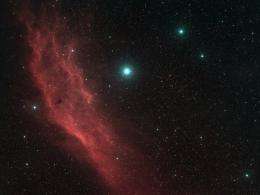The rate of star formation

(PhysOrg.com) -- New stars continue to appear in the night sky, as the gas and dust in giant interstellar clouds gradually coalesces under the influence of gravity until nuclear burning begins.
Precisely how all this happens is an active area of current astronomical research, one which also holds the key to understanding how planets form, how the brightest galaxies shine, and how the early universe produced the chemical elements essential for life. Among the outstanding puzzles: what physical parameters determine the *rate at which stars form?
SAO astronomer Charlie Lada, together with two colleagues, offers important new insights into this question in a paper this month in The Astrophysical Journal. The scientists examined star formation in eleven relatively nearby regions actively producing stars. The regions are quite different from one another in overall mass, with values ranging from about 800 solar-masses to 100,000 solar-masses.
The star formation rates in these regions, based on infrared observations of very young stars, also differ - from a few stars every million years to nearly a thousand stars every million years. But curiously the more massive clouds do not necessarily produce stars at a faster rate - in fact, the new study finds that the most massive cloud, the California Nebula, actually had a very low rate, and was the least efficient. The most efficient region, by comparison, was among the least massive.
The astronomers found that the key predictor of the star formation rate was the density of the material in the cloud above a critical value. They estimated the density by examining the extinction of optical and near infrared light passing through the clouds, since the opacity is the result of dense dust in the cloud. Over the years numerous other predictors have been hypothesized (for example, the total cloud mass), but these new results provide solid evidence for the importance of density.
Provided by Harvard-Smithsonian Center for Astrophysics



















